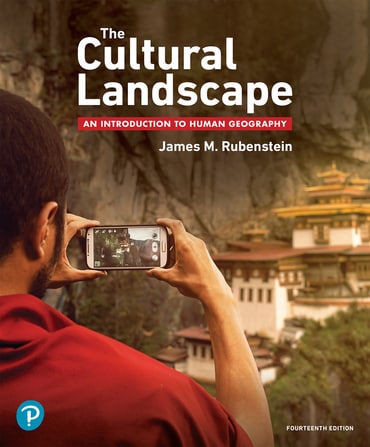
Title overview
For courses in human geography.
Understanding our world and its human landscape
The Cultural Landscape: An Introduction to Human Geography uses a structured learning path to look into the patterns and processes of Earth's human landscapes. Rubenstein explores the relationships between people and their locations, looking at where people and activities are located across Earth's surface and understanding why they are located in particular places.
The 14th Edition supports geography as a visual science with new figures bringing the text's total number to over 1,000. New and updated features visually engage students, and current information and data enhance student understanding and analytic skills.
Hallmark features of this title
- A Structured learning path guides students through visually engaging content with these features:
- Chapter openers feature an introductory paragraph that outlines the 4 key issues and previews them in 1-2 sentences. The opener includes a word cloud and location map.
- 4 Key Issues structure each chapter. After each Key Issue title is a paragraph that introduces the topic. Key Issue Topics divide each Key Issue into several topics.
- Learning outcomes appear below each Key Issue topic, summarizing the principal purpose of that topic.
- Pause & Reflect offers a question tied to a topic to stimulate reflection or discussion.
- End-of-chapter features review content and offer learners opportunities to undertake additional exploration.
New and updated features of this title
- International Geographic Mapping Explorations features ask students to investigate a concept or place discussed in the chapter and answer questions based on observations.
- Visual material supports geography as a visual science with new figures bringing the total number in the text to more than 1,000.
- UPDATED: Thinking Geographically questions are visual, thought-provoking essay-style questions at the end of each chapter that include directions for further reflection. The included image can illuminate the thought or suggest directions for reflection.
- UPDATED: Summary & Review outline the key points as bullets from the chapter's 4 Key Issues. The Summary & Review are part of the Structured Learning Path and now appear on the last page of a chapter's text, rather than at the end of chapter.
- UPDATED: Word clouds on the first page of each chapter visually depict the most important concepts and terms in the chapter.
- UPDATED: Location maps present a spatial overview of each chapter, identifying select places explored in each chapter's applications and case studies.
Key features
Features of Mastering Geography for the 13th Edition
- NEW: International Geographic Mapping Explorations features ask students to investigate a concept or place discussed in the chapter and answer questions based on observations.
- UPDATED: Geospatial Data Analysis interactive map activities leverage GIS-inspired MapMaster in Mastering Geography, allowing students to create maps and analyze spatial patterns and data at regional and global scales. Students can geolocate themselves in the data and upload their own data for advanced mapmaking.
- Data Visualization powered by Social Explorer appears for every key issue and enables students to connect to concepts by engaging with various story maps, predictive graphs, interactive charts and other interactive media.
- Mobile Field Trip videos from Michael Collier give students an avenue for exploring US landscapes and the major themes of physical geoscience concepts.
- Google Earth™ Virtual Tour videos give students brief narrated spatial explorations of places and people around the world, covering critical themes such as globalization and sustainability.
- GeoTutor Activities help students master challenging geography concepts with highly visual, kinesthetic activities focused on critical thinking, data analysis and the application of concepts.
Features of Pearson eTextbook for the 13th Edition
- Place-based Learning empowers students to explore the real world with links to online Google Maps™ that connect students to dynamic web maps supported by community-contributed photos and introduce them to Volunteered Geographic Information (VGI).
- Data Visualization powered by Social Explorer appears for every key issue and enables students to connect to concepts by engaging with various story maps, predictive graphs, interactive charts, and other interactive media.
- International Geographic Mapping Explorations features ask students to investigate a concept or place discussed in the chapter and answer questions based on observations.
Table of contents
- This Is Geography
- Population & Health
- Migration
- Culture & Social Media
- Languages
- Religions
- Ethnicities
- Political Geography
- Development
- Food & Agriculture
- Industry
- Settlements & Services
- Urban Patterns
- Resource Challenges
APPENDIX
MAP SCALE AND PROJECTIONS
Author bios
About our author
Dr. James M. Rubenstein received his B.A. from the University of Chicago in 1970, M.Sc. from the London School of Economics and Political Science in 1971, and Ph.D. from Johns Hopkins University in 1975. He was professor of Geography at Miami University for 37 years, where he taught urban and human geography. Dr. Rubenstein is now a full-time writer. In addition to this book, Dr. Rubenstein is the author of Contemporary Human Geography (5th edition) as well as co-author of Introduction to Contemporary Geography, both published by Pearson Education. He also conducts research in the automotive industry and has published four books on the subject— on the subject—The Changing U.S. Auto Industry: A Geographical Analysis (Routledge); Making and Selling Cars: Innovation and Change in the U.S. Auto Industry (The Johns Hopkins University Press); A Profile of the Automobile and Motor Vehicle Industry: Innovation, Transformation, Globalization (Business Expert Press); and Who Really Made Your Car? Restructuring and Geographic Change in the Auto Industry (W.E. Upjohn Institute, with Thomas Klier). He also writes a weekly column about local food for The Oxford Press. Winston, a lab-husky mix with one brown eye and one blue eye, took Dr. Rubenstein for long walks in the woods most days for 15 years. Sadly, Winston passed away at age 15 a few months before the completion of this book.